Our extra-large special edition is here. Subscribe today and receive the 25% longer issue at no extra cost!
Richard Garfield, Skaff Elias, And Valve On Balancing, Community, And Tournaments In Artifact
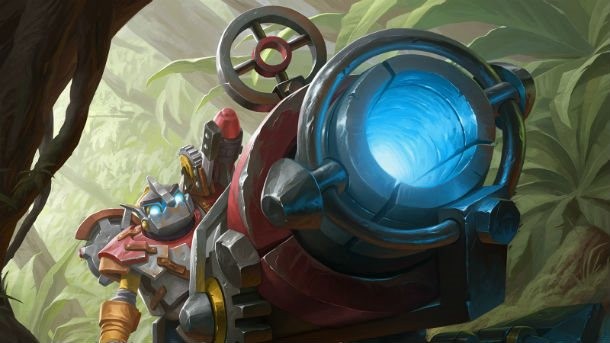
Art Credit: Robbie Trevino.
Earlier this week, I had the chance to play and watch others play Artifact for a few hours at Valve’s HQ in Seattle. To learn how the game works both from a mechanical and financial perspective, head you can read my write-up here.
Before any of that, however, Gabe Newell gave a presentation about the company’s history, the purposes behind each of their games, and what they hope to do with Artifact. It’s an illuminating look at the company, and I recommend you watch it.
Then I had the chance to sit down and chat with a few of the people behind the game, including Magic: The Gathering designers Richard Garfield and Skaff Elias, and ask them a few questions. Read for details about how the game will handle its economy, how Valve gauges success, communication, and balance, and how tournaments will be an integral part of Artifact.
Coming off of Gabe Newell’s talk about some of the stuff he wanted to introduce us with for Artifact, what left me most curious is about your business model with how the game wasn’t going to be free-to-play and that the market would be heavily involved. How much can you tell me about how you expect players to interact with the game financially? What is the buy-in, and how does the marketplace roll into that?
Brandon Reinhart: There will be packs that look a lot like you would expect. You can buy, sell, and exchange singles on the marketplace.
But to access the game…?
Eric Johnson: It will cost money to purchase the game also. We haven’t set a price yet.
When you buy that, will you get cards with that as well? Will it come with a set number of cards?
Jeep Barnett: If you buy the game, you’ll have the ability to play it. [laughs]
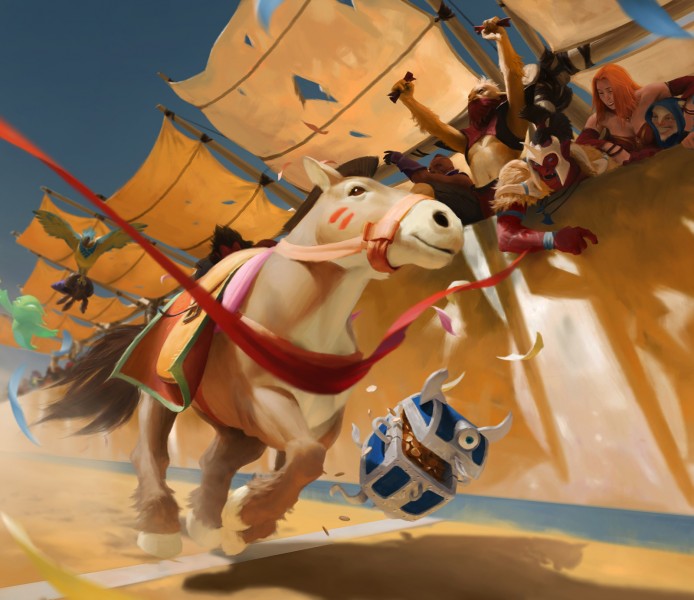
Art Credit: JiHun Lee.
So you’d buy the game and get a certain amount of cards. Is it up to players to go into the market place to buy new cards or will there be a standardized shop?
BR: We won’t sell cards directly. You go to the marketplace and buy them from other players.
How do players go about buying new cards? Do they buy random packs? Where do the cards initially come from?
BR: Cards initially come from packs. We see pack opening as this opportunity for competitive play with draft-style modes, social pack opening - that kind of stuff.
I know Brad [Muir] didn’t want to use the word “trading” earlier, but is that something you’ll be able to do with other players? Say I just got this card I know my friend wanted. Would I be able to send that directly to them?
BR: At launch, we’re going to focus on the marketplace. What we do from there is unknown right now.
Richard, you were one of the big surprises over at Gabe’s talk about how you’re heavily involved in this. How did Valve approach you and talk about making this card game?
Richard Garfield: I approached Valve. When Magic came out in the 90s and then started making electronic versions of it, it was quickly apparent that because it hadn’t been designed for electronic play, it was not optimal. We spent a lot of time trying to solve the problems which Magic brought to the online world. But immediately, that said to me, what is the optimal game? If we designed a trading object game for online, what would it look like? I’ve been thinking about that design and working on various projects ever since then, and at one point I sent a document to Chris Green who I’ve worked with here at Valve on a couple things and he liked what I was laying down and the approach I was talking about. Skaff and I met with Valve and how we could work on this. That’s what got it going.
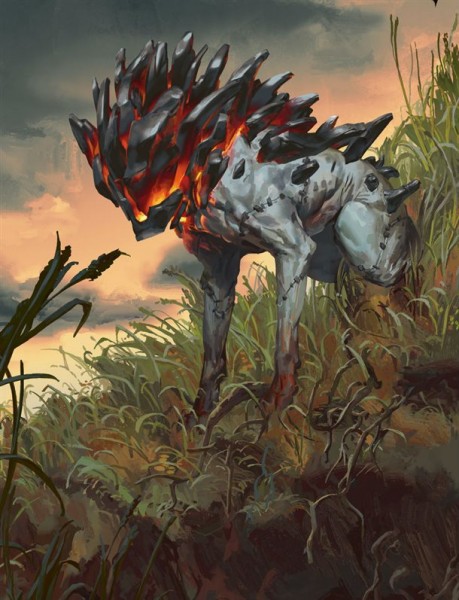
Art Credit: Lake Hurwitz
One of the things that Gabe also mentioned was how you guys don’t have the traditional approach to success and failure with games. You don’t think about “What is the return on this?” When you guys sort of removed that from the equation, how do you guys measure how well something is doing? Do you measure your own progress with external metrics?
EJ: The answer is yes. We do everything. It’s a part of everyone’s job at the company to try and understand the state of the world with respect to their customer base. I actually think it’s a falsehood to think that just because you have access to all this data to generate a true picture of the state of the world - it became really fashionable over the last 5 to 10 years. And while that stuff is super useful, the amount of stuff that customers are buying is really important. Just as much of the picture is reading through how your customers are talking about your product. What are the things that they’re thinking about? It’s about trying to use as many different sources as possible to try and get in the heads of as many customers as possible. When we do The International for Dota, it has a bunch of great, non-obvious side effects to our company. One of those things is that we get to talk to a bunch of people that play Dota in-person and ask whatever questions we want. That’s actually super helpful for us in how we think about running that game, so I think the question you’re asking is so core to how we do our job. How do we understand the state of our customers? We use any piece of data we can possibly find.
JB: We watch all kinds of people play Artifact and it’s really exciting seeing them find a new combo or find a new idea they haven’t considered before like a new way to use a card. It’s super gratifying, and in terms of the health of the community with all the games we’ve worked on, it's really exciting to see people talk about who would win in a fight: Tidehunter or Kunkka? Or what happens when you put a portal inside another portal? When people talk about those sorts of things on that level, that’s what I really view as a healthy community.
A lot of it has to do with recognizing those interactions as important, but also sort of balancing that with the idea of, you know, balance. So you see people do stuff with cards, or even with Dota, things you didn’t expect. What do you think is the line between keeping something cool in a game that you didn’t notice or this is something that might be an issue?
EJ: Is it cool or not? That’s usually the issue. Honestly, with Dota, just because it has more customers … I don’t know how it is with Magic.
JB: [Looking at Skaff and Richard] You two guys can talk about this a bunch more in terms of the meta of card games and how strategies rise. There’s a lot to say on that. How do you decide if something’s a bug or feature?
Skaff Elias: You just declare it a feature and move on. [laughs] You’re trying to give the customer as many options as possible. It takes a long time for the meta to settle down, and then hopefully by that time, you’ve injected more cards. It’s the idea of always having something for your community that keeps playing. And these games are so complicated that I think you’ve failed if you’ve anticipated every combination and every possibility because you’ve set your sights too low. You want to give the audience a true sense of exploration and they can tell if it’s a rich environment to find combinations, that’s a platform for them to innovate on, as opposed to something with few things to connect.
BR: This idea is so fundamental, it’s really where the Artifact comes from. The Artifact is this object that you search for and discover, that you solve a puzzle and you find it. It implies that discovery process.
One of the things Gabe said is that he wanted the game to be unsolvable. As someone who only recently got started with online card games, it always feels like you see a strategy evolve around an ideal deck. This is the ideal with deck, with a few permutations, this is what you should into battle with. How do you guys avoid that being the case?
JB: There’s a huge thing that mitigates that in Artifact. If I were to have someone play the game for a week with a tournament-ready deck versus someone with a random deck who has played it for a month, I bet my life on the guy with the random deck. A huge amount of skill comes from how you play those cards and how you react to your opponent and the cards your opponent plays.
SE: Also part of the general system design, if I know exactly what you’re playing and I know your deck, I can build a deck to beat it. As long as that’s true for every deck, there is no best deck. That is an extremely important part of the process.
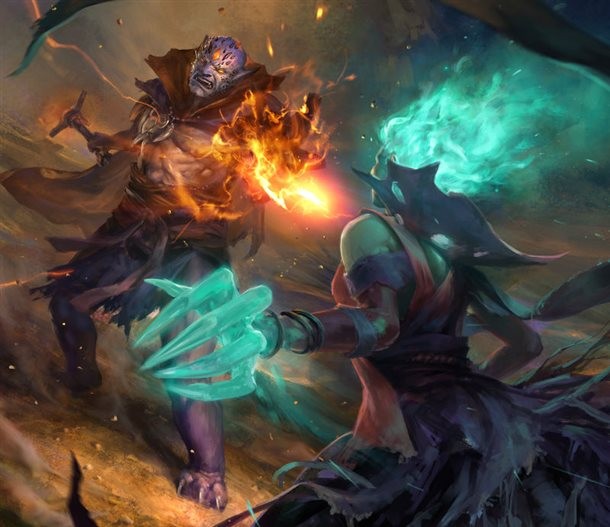
Art Credit: Randy Vargas.
This is maybe more specific to Valve, when it comes to communication you say that you input a lot. One of the things I saw with Dota is that you’re planning to balance more regularly. Is that the same approach you’re taking to Artifact, in terms of having more regular updates? A lot of people describe Valve as a black box where you observe but don’t interject unless you absolutely need to. With Artifact, do you have plans to change that approach?
JB: We have a long history of partnering with our community and making sure we’re building the thing that best serves that community.
SE: Our intention is to update it primarily releasing new cards.
RG: It’s worth noting there that we will nerf and buff cards at an absolute minimum. We probably would never buff a card.
SE: There’s never a reason to buff a card.
RG: The only reason to nerf a card is in the unlikely situation where everyone has to play this card or they’ll lose. We would rather let the metagame play out and if a card is a problem, it’s going to go away anyway.
So you plan to use that rotating format?
RG: Yes.
Another thing that Gabe mentioned is that the single player experience would be defined mostly by teaching. You play against an AI to learn the game. How extensive is that? Is it like here’s a bot, you can test whatever you want, or do you plan to have hey, here’s not only the rules of the game but here’s a few tips on how to deck build or other aspects of the game and strategizing?
JB: The community will do a lot of that for us. People will write guides and teach each other what they think is a good or interesting way to play.
With Dota, there’s a lot of that stuff in-game. Do you plan to implement that at some point, despite Artifact’s difference from Dota? Would there be some sort of reward for people writing guides?
JB: I actually hadn’t thought about this, but we have a really brilliant AI programmer. Watching the plays that the AI makes sometimes has given me interesting ideas about the heuristics that I should consider for a play. Maybe just watching that AI would help players learn something new.
RG: It’s worth pointing out that the AI is really quite good. When we say that there’s no campaign or no single player content to speak of and people will want to play against other people, we’re really underselling the AI. Playing AI against most board and card games, but this one you could play against the AI and have a lot of fun and learn a lot.
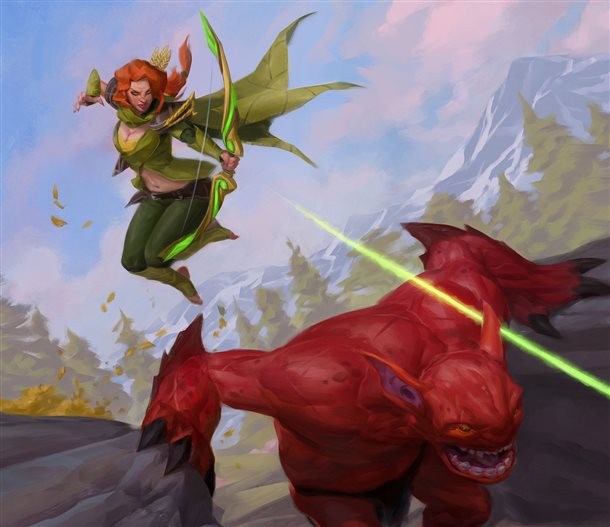
Art Credit: Kieran Yanner.
From a community standpoint, you said you’re planning on having a million dollar tournament, things like that. Where do you see yourselves building off of Dota? Is that sort of the start here? With Dota, it seemed to start off a little hands-off with tournaments and then tightening the grip a little bit. When you guys think of that, how much do you plan to emulate what you have now versus trying something new?
JB: [Looking at Eric] You can speak to this better because you’ve covered the tournament scene, but if you look at TF2, CS:GO, and Dota, they all handle the competitive scene differently. It’s about what fits the needs of the community and what they’re looking for.
EJ: It’s a game design exercise. The same people who designed the game or going to determine how tournaments are administered. I think the idea of the community having some interaction with the price pool is pretty interesting. You want to learn about the community, who the pros are and get things rolling to design the best possible tournament.
JB: We’ve also learned a lot from Richard and the staff who have participated in card tournaments for years. You should talk about the grass roots stuff a little bit.
SE: The plan for the tournaments is to not just focus on the top level, but there should be tournaments for all different levels of play. Magic does very similar things and that’s absolutely something we want to emulate. We don’t want to put on only a few elite tournaments a year where a few people play and everybody else watches.
Gabe did mention that there would be more regular tournaments within the game itself. Do you guys have a plan for players who do well in these in-game tournaments and getting them to the next level?
SE: Not just a plan, but too many plans. We still have to work on them, but yes, there are plans, but nothing is settled.
RG: It’s really exciting to play in tournaments and it’s a shame that only the top one percent of the one percent can really do it.

Get the Game Informer Print Edition!
Explore your favorite games in premium print format, delivered to your door.
- 10 issues per year
- Only $4.80 per issue
- Full digital magazine archive access
- Since 1991









